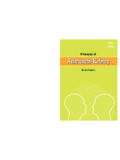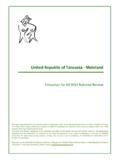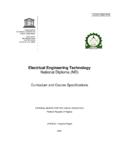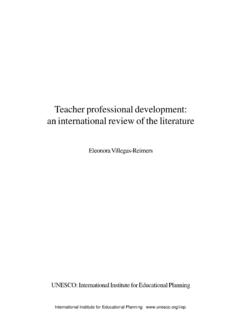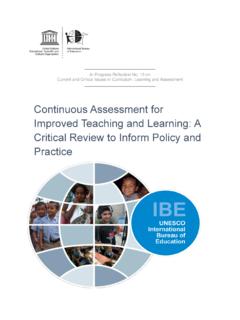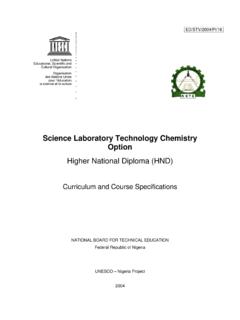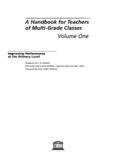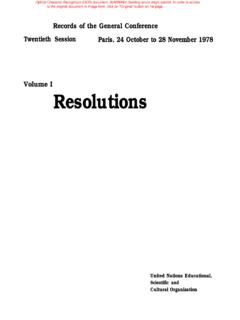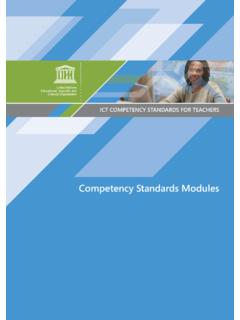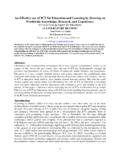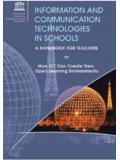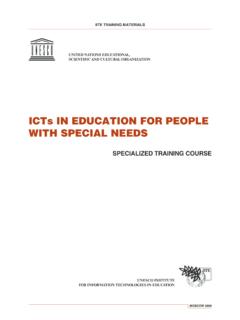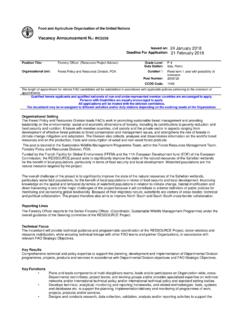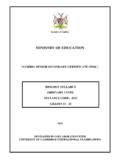Transcription of INFORMATION AND COMMUNICATION - UNESCO
1 INFORMATION AND COMMUNICATIONTECHNOLOGY IN EDUCATIONA CURRICULUM FOR SCHOOLS AND PROGRAMME OF TEACHER DEVELOPMENTUNESCOCo-ordinator: Evgueni KhvilonEditorial co-ordinator: Mariana PatruEditors and Contributors: Jonathan Anderson, Flinders University (Australia)Tom van Weert, Chair of IFIP Working Party (The Netherlands)IFIP Working Party:Yvonne Buettner (Switzerland)Charles Duch teau (Belgium)Catherine Fulford (USA)Pieter Hogenbirk (The Netherlands)Mike Kendall (UK)Raymond Morel (Switzerland)Other Contributors:Siva Alagumalai (Singapore)Alexey Semenov (Russia) John Warren (Australia)Graphic design: Vladimir Kuznetsov (Russia)Cover design: Bertrand Ambry ( UNESCO )Cover photo credit: Tatyana Khvilon, Institute of New Technologies (Russia)For further INFORMATION , please contact:Mariana PatruDivision of Higher EducationUNESCO7, place de Fontenoy75352 Paris 07 SP, : 33-1-45 68 08 07 Fax:33-1-45 68 56 26E-mail: authors are responsible for the choice and presentation of facts contained in this publication andfor the opinions expressed therein, which are not necessarily those of UNESCO and do not committhe Organization.
2 The designations employed and the presentation of the material throughoutthis publication do not imply the expression of any opinion whatsoever on the part of UNESCO concerning the legal status of any country, territory, city or area or of its authorities, or concerningthe delimitation of its frontiers or of Higher Education UNESCO 2002 Printed in FranceED/HED/TED/13 FOREWORDI nformation and COMMUNICATION technology (ICT) has become, within avery short time, one of the basic building blocks of modern society. Manycountries now regard understanding ICT and mastering the basic skills andconcepts of ICT as part of the core of education, alongside reading, writingand of UNESCO s overriding aims is to ensure that all countries, bothdeveloped and developing, have access to the best educational facilities nec-essary to prepare young people to play full roles in modern society and tocontribute to a knowledge nation.
3 Maintaining a capacity to advise nationalgovernments on the use of technology in schools and, in particular, on theoptimal balance, given local circumstances, between ICT and older educa-tional technologies and assisting countries in developing educational soft-ware and materials that reflect their own national and regional cultures arekey components of the Organization s strategy to achieve the Education present publication, INFORMATION and COMMUNICATION Technology inEducation: A Curriculum for Schools and Programme of Teacher Development,is the last in a series of thematically complementary publications developedin 2002 by the Division of Higher Education and should be seen asUNESCO s contribution to assist Member States in successfully integratingthe new technologies such as multimedia, e-learning and distance educationdelivery into their educational book pursues two key purposes.
4 The first is to specify a curriculumin ICT for secondary schools that is in line with current international second is to propose a programme of professional development forteachers necessary to implement the specified ICT curriculum addition, it provides a practical and realistic approach to curriculum andteacher development that can be implemented quickly and cost effectively,according to available gives me pleasure to acknowledge the genuine international co-operationspirit thanks to which this new publication has seen the light of day and the con-tribution of several internationally renowned experts from Asia, Australia,Europe and North America. A word of sincere thanks goes to the InternationalFederation for INFORMATION Processing (IFIP) for having been the initiator ofthis DanielAssistant Director-General for Education4 ICT IN EDUCATIONA CURRICULUM AND PROGRAMME OF TEACHER DEVELOPMENT5 CONTENTSI.
5 ICT AND EDUCATION8 Aims and Purposes8 INFORMATION and COMMUNICATION Technology9 Curriculum and Teacher Development10 Varying Conditions Across Countries11 Terminology12II. MODELLING ICT DEVELOPMENT14A Continuum of Approaches15 Stages of Teaching and Learning16A Curriculum Structure for Secondary Schools18 Professional Development of Teachers19 III. ICT DEVELOPMENT AT THE SCHOOL LEVEL21 Approaches to ICT Development21 Characteristics of Schools Related to ICT Development23A Matrix for ICT Development in Schools26 Emerging approach26 Applying approach30 Infusing approach32 Transforming approach34IV. ICT CURRICULUM FOR SECONDARY STUDENTS37 ICT Literacy37 Application of ICT in Subject Areas38 Infusing ICT across the Curriculum40 ICT Specialization41V. PROFESSIONAL DEVELOPMENT OF TEACHERS43 ICT Development in Schools43 Developing ICT Skills and Knowledge45 Conducting professional development45 Further points to consider48 Applying ICT to Teachers' Subject Areas49 Teacher competencies49 Organizing teacher development51 Further points to consider52 Infusing ICT to Improve Learning53 Teacher competencies53 Organizing teacher development55 Further points to consider56 Supporting Infusion of ICT in Schools56 Role requirements for support teachers in ICT57 Organizing teacher development59VI.
6 A BLUEPRINT FOR CURRICULUMAND TEACHER DEVELOPMENT60 Modelling ICT Development60 Tracking ICT Development in Schools61A Blueprint for Curriculum61A Blueprint for Teacher Development62A Blueprint for Textbook Writers62 GENERAL REFERENCES63 APPENDICES65 APPENDIX A ICT LITERACY66 Unit A1 Basic Concepts of ICT66 Unit A2 Using the Computer and Managing Files69 Unit A3 Word Processing71 Unit A4 Working with a Spreadsheet73 Unit A5 Working with a Database74 Unit A6 Composing Graphical (Re)presentations76 Unit A7 Computers and Communication78 Unit A8 Social and Ethical Issues80 Unit A9 Jobs and/with ICT82 APPENDIX B APPLICATION OF ICT IN SUBJECT AREAS84 Unit S1 ICT in Languages85 Unit S2 ICT in Natural Sciences86 Unit S3 ICT in Mathematics88 Unit S4 ICT in Social Sciences90 Unit S5 ICT in Art91 Unit B1 Measurement93 Unit B2 Modelling and Simulation956 ICT IN EDUCATIONA CURRICULUM AND PROGRAMME OF TEACHER DEVELOPMENTUnit B3 Robots and Feedback Devices97 Unit B4 Statistics99 Unit B5 Creating Graphics101 Unit B6 Music102 Unit E1 Spreadsheet Design104 Unit E2 Database Design106 APPENDIX C INFUSING ICT ACROSSTHE CURRICULUM108 Unit C1 Encouragement to Reading110 Unit C2 Are We Becoming Genetically Modified?
7 112 Unit C3 Antarctica 2000113 Unit C4 Multimedia and Languages114 Unit C5 The Parking Garage Problem115 Unit C6 The 1920s and its Excesses116 Unit C7 Le Village Prologue117 Unit C8 Society s Problems118 APPENDIX D ICT SPECIALIZATION120 Specialization Preparation Module121 Unit SP1 Introduction to Programming121 Unit SP2 Top-Down Program Design125 General Specialization Module128 Unit GS1 Foundations of Programmingand Software Development129 Unit GS2 Advanced Elements of Programming133 Vocational Specialization Module137 Unit VS1 Business INFORMATION Systems138 Unit VS2 Process Control Systems142 Unit VS3 Project AND EDUCATIONI nformation and COMMUNICATION technology (ICT) has become, within avery short time, one of the basic building blocks of modern society. Manycountries now regard understanding ICT and mastering the basic skills andconcepts of ICT as part of the core of education, alongside reading, writ-ing and book deals with ICT in secondary schools, and with the chang-ing competencies required of both students and teachers if they are tofunction effectively in today's society.
8 It specifies an ICT curriculum forsecondary schools, and outlines an accompanying programme of teacherdevelopment to implement such a AND PURPOSESUNESCO aims to ensure that all countries, both developed and develop-ing, have access to the best educational facilities necessary to prepare youngpeople to play full roles in modern society and to contribute to a knowl-edge nation. Because of the fundamental importance of ICT in the task ofschools today, UNESCO has previously published books in this area as apractical means of helping Member States: for example, Informatics forSecondary Education: A Curriculum for Schools (1994)and Informatics forPrimary Education(2000). Rapid developments in ICT now demanda completely new document in place of the first of these book has two key purposes. The first is to specify a curriculum inICT for secondary schools that is in line with current international second purpose is to outline a programme of professional develop-ment for teachers necessary to implement the specified ICT AND EDUCATIONAll governments aim to provide the most comprehensive education pos-sible for their citizens within the constraints of available finance.
9 Because ofthe pivotal position of ICT in modern societies, its introduction into sec-ondary schools will be high on any political agenda. This book gives a prac-tical and realistic approach to curriculum and teacher development that canbe implemented quickly and cost effectively, according to available curriculum is designed to be capable of implementation throughoutthe world to all secondary age students. The programme of teacher profes-sional development relates closely to the ICT curriculum, and particularly tothe stage of development that schools have reached with respect to AND COMMUNICATION TECHNOLOGYICT permeates the business environment, it underpins the success ofmodern corporations, and it provides governments with an efficientinfrastructure. At the same time, ICT adds value to the processes oflearning, and in the organization and management of learning institu-tions.
10 The Internet is a driving force for much development and innova-tion in both developed and developing must be able to benefit from technological be able to do so, a cadre of professionals has to be educated with soundICT backgrounds, independent of specific computer platforms or soft-ware developments lead to changes in work and changes inthe organization of work, and required competencies are thereforechanging. Gaining in importance are the following competencies: critical thinking, generalist (broad) competencies, ICT competencies enabling expert work, decision-making, handling of dynamic situations, working as a member of a team, and communicating secondary ICT curriculum should contribute to the building up ofteams of professionals with these new use of ICT cuts across all aspects of economic and social developments in ICT are very rapid.
